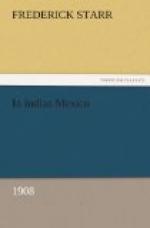The young man who had been most interested in our proper understanding of the costumbre was anxious that we should see the village idols. These are kept concealed, apparently in a cave, though it is possible that they are buried in the ground. At all events, they exist, and in considerable number. A lively discussion ensued as to whether it would be proper to show them to us, and it was decided that nothing ought to be done until the old woman, who is at the head of the pagan practices of the village, should be present. It seems that in the costumbre, already described, there are four priests or leaders. One of these is the old woman just mentioned, and the other three are men. She was sent for, and while we waited, we were told that, if we desired to see the lanterns that were used in the last costumbre, they were still preserved in the santocalli. Santocalli is a mongrel word—from Spanish santo, saint, and the Aztec calli, house. It was a little structure of adobe and canes, close to the schoolhouse, and fronting with it upon the little plaza of the village. It had a two-pitched thatched roof and a single door in the front. After some demur, it was opened, and we entered. It consisted of a single plain room with two benches made of beams along the wall. At the back was a terrible Christ and Virgin, and, to the right and behind, another Virgin. These Virgin figures were both small and unattractive, and both wore quichiquemils. In front of the Christ and larger Virgin was a simple altar built against the wall. In the floor, directly in front of it, were four small hollows. To the right of the altar, a flat stone was set into the floor. In front of the altar stood a small table on which were censers and candle-sticks. Underneath this table, the space between the four legs was occupied by a heap of ashes; in front and behind this were ill-defined basin hollows. To beams in front of these were hung the almost globular paper lanterns already mentioned. When we had seen these lanterns, and were about to leave, the old bruja appeared, with her female acolyte. She was furious over the desecration of strangers entering the santocalli, without her presence. She was a striking figure; very small, with a wrinkled, shrewd and serious, but not unkind, face; her white hair was almost concealed by her rebozo, which was folded square and laid upon her head with a portion flowing behind. The most striking thing was her great devotion, and complete unconcern regarding all around her. Entering, she hastened to the altar, knelt,—touched her forehead to the edge—and in a clear but not loud voice crooned an impassioned cry to Christ, to San Jose and to the Virgin. Imperiously turning to her acolyte, she seized the censer filled with copal, and, having lighted it, incensed the figures. Turning to the presidente, she asked whether he were going to placate the saint for invasion by




